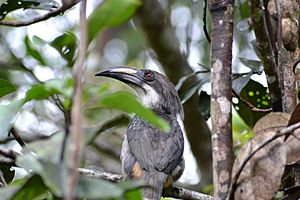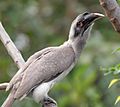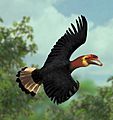Hornbill facts for kids
Quick facts for kids Hornbills |
|
|---|---|
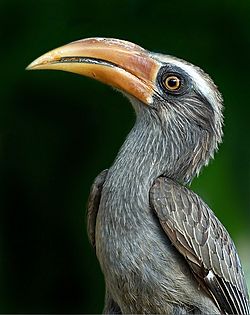 |
|
| Malabar grey hornbill Ocyceros griseus |
|
| Scientific classification | |
| Kingdom: | |
| Phylum: | |
| Class: | |
| Order: | |
| Family: |
Bucerotidae
Rafinesque, 1815
|
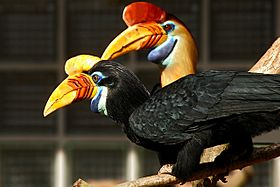
Hornbills (Bucerotidae) are a group of birds found in warm, tropical parts of Africa, Asia, and Melanesia. They have a long, curved beak that often has bright colors. Some hornbills even have a special box-like growth on top of their upper beak.
Female hornbills lay their eggs inside a hole in a tree. With help from the male, she seals herself inside the nest. She uses mud and her own droppings to cover the entrance. Only a small slit is left. Through this tiny opening, the male brings her food. This clever trick keeps the nest safe from predators like snakes. The mother and chicks stay safe until the young birds are old enough to fly.
Contents
Amazing Features of Hornbills
Hornbills come in many different sizes. The smallest is the black dwarf hornbill, which weighs about 102 grams (like a small apple) and is 30 centimeters long. The largest is the southern ground hornbill, which can weigh up to 6.2 kilograms (like a small dog) and be 1.2 meters tall.
Male hornbills are always bigger than females. However, how much bigger they are depends on the species. For example, the difference in body weight between males and females can be from 1% to 17%. But for beak length, the difference can be much larger, from 8% to 30%.
Their Unique Beaks
The most special part of a hornbill is its heavy beak. Strong neck muscles and fused bones in their neck help support this large beak. The big beak helps them fight, clean their feathers, build their nests, and catch food.
A feature found only in hornbills is the casque. This is a hollow structure that runs along the top of their upper beak. In some species, it is very small and seems to only make the beak stronger. In other species, it is quite large and has bone inside. It can even act like a speaker, making their calls louder.
The helmeted hornbill has a casque that is not hollow. It is filled with a material called hornbill ivory. This bird uses its casque like a battering ram in amazing fights in the air. The great hornbill has also been seen using its casque to butt heads in the air.
Colors and Eyes
Hornbills usually have feathers that are black, grey, white, or brown. But their beaks, faces, or wattles (fleshy growths) often have bright colors. Some species have different colors for males and females. For example, the female Abyssinian ground hornbill has pure blue skin on her face and throat. The male has red and blue skin. Hornbill calls are loud and sound very different from one species to another.
Hornbills have binocular vision, which means they can see with both eyes at once. This helps them judge distances. Even though their large beak is in their way, they can still see the tip of it. This helps them pick up food very precisely. Their eyes also have long eyelashes, which act like a sunshade.
Where Hornbills Live
There are about 55 different kinds of hornbills alive today. They live in Sub-Saharan Africa, the Indian subcontinent, the Philippines, and the Solomon Islands. No single type of hornbill lives in both Africa and Asia.
Most hornbills live in trees. However, the large ground hornbills, as their name suggests, live on the ground in open savanna areas. In Africa, 13 of the 24 hornbill species live in open woodlands and savannas. Some even live in very dry places. The other African species live in thick forests.
In Asia, it's different. Only one species lives in open savannas, and all the others live in forests. The Indian subcontinent has 10 species of hornbills. Nine of these are found in India and nearby countries. The Sri Lanka grey hornbill lives only on the island of Sri Lanka. The most common hornbill in the Indian subcontinent is the Indian grey hornbill.
According to the International Union for Conservation of Nature (IUCN), Indonesia has 13 hornbill species. Nine of them live in Sumatra. The others live in Sumba, Sulawesi, Papua, and Kalimantan. Kalimantan has the same hornbill species as Sumatra, except the great hornbill is not found there.
Long ago, in the Miocene era, hornbills also lived in North Africa and South Europe. Scientists have found their remains in Morocco and Bulgaria.
Hornbill Behavior and Life
Hornbills are active during the day. They usually travel in pairs or small family groups. Sometimes, outside of the breeding season, larger groups can form. The biggest gatherings of hornbills happen at their roosting (sleeping) sites. As many as 2400 birds have been seen together at one time.
What Hornbills Eat
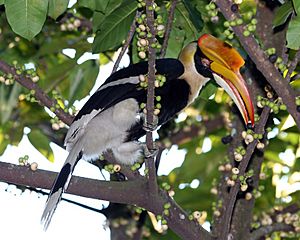
Hornbills are omnivores, meaning they eat both plants and animals. Their diet includes fruit, insects, and small animals. They cannot swallow food caught at the very tip of their beak because their tongues are too short. So, they toss the food back to their throat with a quick jerk of their head.
Hornbills that live in forests often eat mostly fruit. Those that live in open areas tend to eat more meat (insects and small animals). Forest hornbills are important because they help spread seeds from the fruits they eat.
Some hornbills defend a specific area as their territory. Whether they do this depends on what they eat. Fruit sources can be spread out, so fruit-eating hornbills often have to travel long distances to find food. Because of this, fruit-eating species are less likely to defend a fixed territory.
Hornbill Reproduction
Hornbills usually form pairs that stay together for life. However, some species work together to raise their young. The female lays up to six white eggs in existing holes or cracks, usually in trees or rocks. These holes are often natural, but some hornbills might use old nests made by woodpeckers or barbets. The same pair might use the same nesting spot for many breeding seasons.
Before the eggs hatch, the female hornbill starts to close the entrance to the nest hole. She uses a wall made of mud, droppings, and fruit pulp. Sometimes the male helps her. When the female is ready to lay her eggs, the opening is just big enough for her to get inside. After she enters, the remaining opening is almost completely sealed shut. Only a narrow slit is left. This slit is just big enough for the male to pass food to the mother and, later, to the chicks. This behavior seems to protect the nest from other hornbills that might try to take it over.
Sealing the nest can take just a few hours, or at most, a few days. After the nest is sealed, it takes about five more days for the first egg to be laid. The number of eggs laid depends on the species. Larger hornbills lay one or two eggs, while smaller ones can lay up to eight.
While she is in the nest, the female loses all her feathers at once. Scientists think the darkness inside the nest might trigger a hormone that causes this feather loss. Hornbills that are not breeding, and males, lose their feathers one by one over time. When the chicks and the female become too big to fit in the nest, the mother breaks out. Then, both parents feed the chicks. In some species, the mother rebuilds the wall. In others, the chicks rebuild the wall by themselves. Ground hornbills do not seal themselves in their nests; they are regular cavity-nesters.
Hornbills and Other Animals
Some hornbills have special relationships with other animal species. For example, some African hornbills have a helpful relationship with dwarf mongooses. They look for food together and warn each other if birds of prey or other predators are nearby. Other relationships are more one-sided but harmless. For instance, hornbills might follow monkeys or other animals and eat the insects that these animals stir up from the ground.
Images for kids
-
Close-up of a Great hornbill
-
Close-up of head of a Malabar grey hornbill showing eyelashes
-
Male black-casqued hornbill (Ceratogymna atrata) on display at the Museum of Osteology.
-
The Indian grey hornbill is an overall grey bird and native to the Indian subcontinent. So are other members of genus Ocyceros.
-
All members of Anthracoceros, like these Palawan hornbills, have a pied plumage
-
The uniquely long-tailed helmeted hornbill is commonly placed in its own genus, though some place it in Buceros
-
Like all Bycanistes, the black-and-white-casqued hornbill has pied plumage and a dull beak. It is found in wooded habitats in Africa.
-
Southern ground hornbill (bluish throat indicates female) about to swallow a grasshopper
-
The rufous-headed hornbill is among the most threatened hornbills.
See also
 In Spanish: Bucerotinae para niños
In Spanish: Bucerotinae para niños



